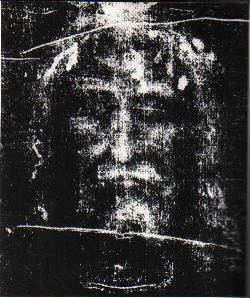The Holy Shroud of Turin is the most guarded and controversial relic in Christianity. If ever authenticated beyond a shadow of a doubt it will certainly be the most precious.
The cloth measuring 14ft. 5 in. by 3ft. 8 in. lies in a reliquary in the chapel of the dukes of Savoy at Turin Cathedral. It's resting place since 1578.
To date the shroud has long been debated and extensively studied. During the early Christian persecutions the shroud was hid. Then the Bzantine rulers of Constantinople acquired the Shroud and kept it in the city until its fall in 1204.
The Shroud was taken by Crusaders to Besancon Cathedral in the French province of Doubs. It was rescued from a fire in 1349.
The first documented display of the Shroud dates back to 1389. Geoffroi de Charnay, a French knight, wrote to Clement VII, the Avignon anti-pope, telling him of the cloth he had inherited from his father.
The cloth was presented to the dukes of Savoy in 1432. The Shroud had been slightly damaged in another fire at the Ducal palace. The Shroud was moved to the cathedral at Turin. The shroud is occasionally put on display and visited by millions.
The First Photograph
In 1898 the first photographs of the Shroud was taken. Secondo Pia, an archeological photographer, found that his negative plates gave an even clearer image of the figure than the cloth.
Dr. Yves Delage, a French physician, began an extensive investigation into the relic and presented his findings to the French Academy of Sciences in 1902.
Dr. Delage's colleague, Paul Vignon, theorized that the stain's on the Shroud were caused by perspiration and spices found in the cloth.
Dr. Delage reported that the image on the cloth perfectly detailed the body of a man that had undergone extreme torture associated with a crucifixion.
The face was beaten. There was severe bruising and swelling of the right cheek. the right eyelid was sharply contracted. The nose was injured. Bloodstains on the back and the forehead indicated that the skin had been punctured.
The entire body with the exception of the face, hands and feet had been scourged by a two-thronged lash, studded with balls of lead or bone. Apparently the body had been thrashed by two people.The marks were the worst on the chest and abdomen. The shoulders were wounded when the man had carried a heavy object. Both knees were sliced as if he had fallen heavily. There were bloodstained wounds that could have been caused by nails that were driven into the wrists and feet.
The wrist wounds were just behind the ball of the hand. A large wound was prevalent on the right side, between the 5th and 6th ribs. There was corresponding stain of blood and a colorless liquid, possibly fluid from a pierced lung.
The body had been sprinkled with aloes. However, contrary to tradition the body ad not been washed or anointed. Suggesting it had been a hasty burial.
Dr. Delage summed up by saying;"On the one hand,we have the shroud, probably impregnated with aloes, which brings us to the East outside Egypt, and a crucified man who has been scourged. On the other we have an account, pertaining to history, legend and tradition, showing Christ undergoing in Judea the same treatment as we decipher on the body whose image is on the shroud."
The result was a controversy that is still argued today. Skeptics claim the image is a painting. Br. Delage points out that there is no trace of pigment on the shroud. The shroud had been authenticated since the 14th century. The artist would have had to be capable of creating a work beyond the abilities of the greatest Renaissance painters. It would also be nearly impossible to paint a negative with such accuracy.
The Second Photos and Germany Conventions
In 1931 Guiseppe Enrie was commissioned to take pictures of the Shroud. Enrie's plates were much better than ones taken in 1898. Enrie studied the plates long and hard and at last declared," the imprint is not the work of an artist. The enlargements confirmed Dr. Delage's assessment that there was no trace of pigment on the cloth."
In the 1950's conventions were formed in Germany to closely scrutinize the shroud. In 1959 the convention petitioned Pope John XXIII to allow a small portion of the Shroud to be removed for chemical and microscopic examination. The appeal was dismissed without explanation.
Kurt Berna, a german writer that also made a study of the shroud, made this observation. The bloodstains on the shroud indicate that the mans heart was still beating after he was taken down from the Cross. If he had died before he was taken down the wounds would have ceased to bleed and blood outside of the body would 've congealed.
Berna says that if this is the shroud of Christ, he was not killed by the crucifixion. He states that photographic reconstruction show that a lance thrust into His body did not pierce His heart.
Berna believes that Jesus lost consciousness and stopped breathing because of the torture, loss of blood, or fumes from the vinegar offered him.
The centurions believed Jesus was dead and removed Him from the cross to be buried. In the tomb Berna believes the aloes and cold atmosphere revived Him and then He appeared alive to the disciples before the Ascension.
Berna also points out that the wounds in the wrist lend authenticity to the shroud. If the nails had been driven through the hands they would 've been torn out by the weight of the body.
Dr. David Willis, an English police surgeon, noted that the thumbs of the image were sharply retracted. This is consistent with the wounds in the wrist, the nails were driven through the median nerve.
1988 Carbon Dating
In 1988 the shroud was carbon dated and the test revealed that the shroud was fake dated around the middle ages. However, this test might have been contaminated by the two previous fires.
Extreme scrutiny showed that oxidation and dehydration were the culprits behind the image, not a painting process. Traces of human sweat and blood revealed by new analysis implied the Shroud was not a fake.
1999 Pollen Find
A decade later in 1999 serious doubts were cast on the 1988 carbon dating. An Israeli scientist found that the most common pollen found on it comes from a plant that could have been used to weave the crown of thorns placed on Christ's head.
2000 Textile Analysis
Then this year (2000) a SWISS scientist Michthild Flury Lemberg, leading authority on the history of textiles, was helping to restore the shroud and made a startling discovery. Lemberg found a strong similarity between the shroud and fragments of cloth produced in the Middle East about 2,000 years ago. This prompted the Vatican to order new tests. Lemberg stated, " In my opinion, the shroud is not a medieval fake. The parallels I have found indicate that it could have existed at the same time as Jesus Christ and in what is now Israel."
Is this Fascinating Mystery a photographic record of Christ's death?






